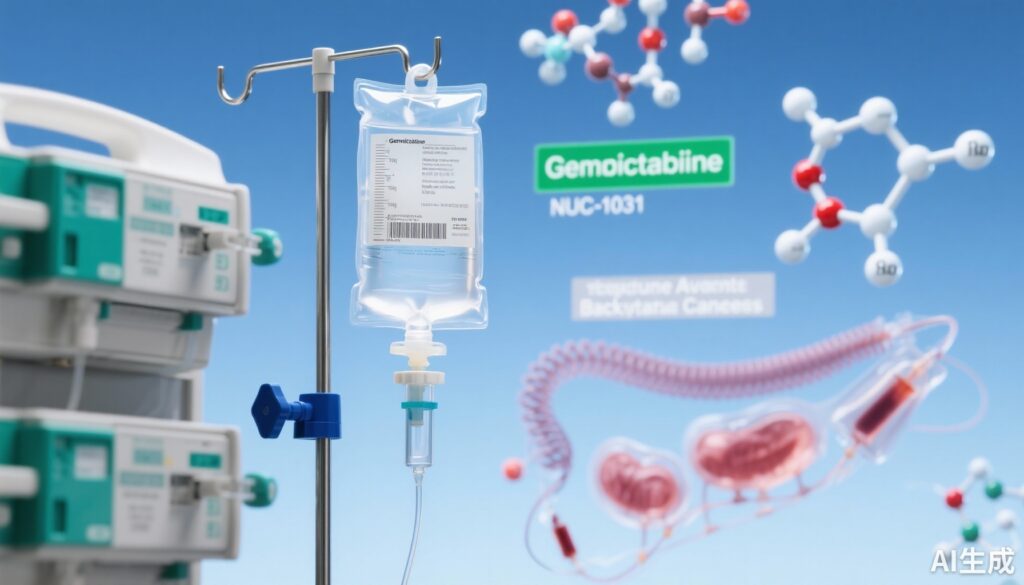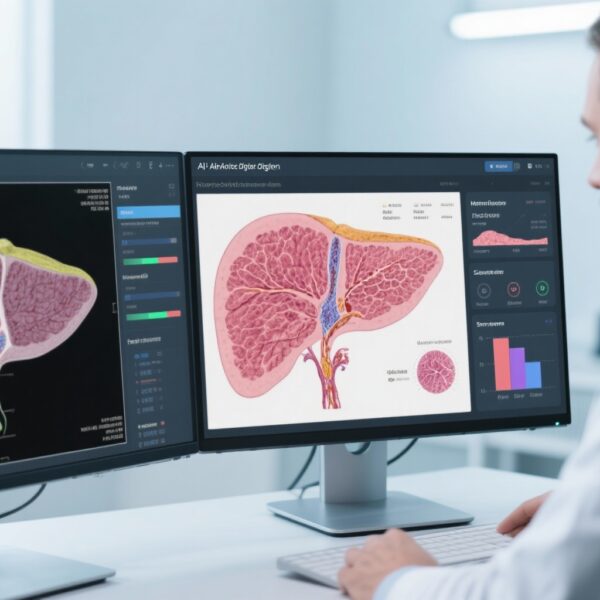Study Background and Disease Burden
Advanced biliary tract cancer (aBTC), encompassing intrahepatic and extrahepatic cholangiocarcinoma, gallbladder cancer, and ampullary cancer, remains a therapeutic challenge due to its aggressive biology and late presentation. The current first-line standard treatment—gemcitabine combined with cisplatin—has been the backbone of management since the landmark ABC-02 trial; however, its benefits are modest, with median overall survival (OS) around 11-12 months and limited durable responses. The high unmet need for improved therapeutic options drives ongoing efforts to develop more effective agents or formulations that enhance delivery and overcome resistance mechanisms.
NUC-1031 is a novel phosphoramidate modification of gemcitabine designed to enhance intracellular delivery, bypass resistance pathways such as nucleoside transport limitations, and increase the active metabolite concentrations within tumor cells. Preclinical and early-phase clinical studies suggested promising activity and a manageable safety profile, warranting investigation in a large randomized phase III setting.
Study Design
The NuTide:121 study was a global, open-label, multicenter, randomized phase III trial enrolling adult patients with treatment-naïve advanced biliary tract cancer. Patients were randomized 1:1 to receive either NUC-1031 plus cisplatin or the standard comparator of gemcitabine plus cisplatin. Both regimens were administered on Days 1 and 8 of 21-day cycles until disease progression or unacceptable toxicity.
The primary endpoints were overall survival (OS) and objective response rate (ORR) assessed by blinded independent central review. Progression-free survival (PFS) and safety were key secondary endpoints. The protocol included three planned interim analyses to assess futility and efficacy, with early stopping rules predefined.
Key Findings
The trial randomized 773 patients, with 388 allocated to NUC-1031/cisplatin and 385 to gemcitabine/cisplatin. Baseline demographics and disease characteristics were well balanced, with a median age of 65 years, 53% males, and tumor types predominantly consisting of intrahepatic cholangiocarcinoma (54%), extrahepatic cholangiocarcinoma (21%), gallbladder cancer (21%), and ampullary cancer (5%).
At the first interim analysis, the OS futility boundary was crossed, prompting early enrollment suspension and subsequent final analysis. Median OS was significantly shorter in the NUC-1031 arm at 9.2 months (95% CI 8.3-10.4) compared to 12.6 months (95% CI 11.0-15.1) in the gemcitabine arm (hazard ratio [HR] 1.79), indicating no survival advantage. Median PFS also favored gemcitabine/cisplatin (6.4 vs. 4.9 months; HR 1.45).
Interestingly, the NUC-1031/cisplatin combination showed a higher objective response rate: 18.7% versus 12.4% in the gemcitabine arm (odds ratio 1.59, p=0.049). However, this did not translate into longer survival or progression control.
The safety profile revealed a comparable overall adverse event rate between arms but with notable differences. Hepatobiliary disorders were significantly higher in the NUC-1031 group (25% versus 11%), alongside higher incidences of potential drug-induced liver injury (27% vs. 7%) and cases meeting Hy’s law criteria (1.6% vs. 0.5%). In contrast, hematological toxicities were more frequent with gemcitabine/cisplatin (65% vs. 48%). Treatment exposure was lower in the NUC-1031 arm, with more patients discontinuing early due to adverse events (30% vs. 18%).
Expert Commentary
The NuTide:121 trial underscores the complexity of improving first-line therapy for aBTC. While NUC-1031 was rationally designed to augment gemcitabine pharmacodynamics, the clinical outcomes highlight that preclinical advantages do not always translate into patient survival benefits. The increased hepatotoxicity observed may have contributed to early treatment discontinuations and diminished efficacy.
Given the modest efficacy and substantial liver-related toxicity, the data do not support replacing gemcitabine with NUC-1031 in combination with cisplatin. This reflects the broader challenges in aBTC drug development, including tumor heterogeneity, pharmacokinetic variability, and the aBTC patients’ diminished baseline hepatic function, which may predispose to drug-induced liver injury.
Study limitations include the open-label design, which though mitigated by blinded independent review for response, may influence some subjective endpoints. Additionally, early trial termination could limit assessment of long-term outcomes or subgroup efficacy signals.
Conclusion
The NuTide:121 phase III trial comparing NUC-1031/cisplatin versus standard gemcitabine/cisplatin in previously untreated advanced biliary tract cancer failed to demonstrate an overall survival benefit and was terminated early due to futility. Although an improved response rate was recorded with NUC-1031, increased hepatotoxicity and early discontinuations likely compromised treatment effectiveness. These findings reaffirm gemcitabine/cisplatin as the first-line standard of care for aBTC and emphasize ongoing challenges in identifying superior therapeutic strategies in this vulnerable population.
Future research should continue exploring novel agents with favorable toxicity profiles and investigate personalized approaches incorporating molecular profiling to better target this heterogeneous disease.
References
Knox JJ, McNamara MG, Bazin IS, Oh DY, Zubkov O, Breder V, et al. A phase III randomized study of first-line NUC-1031/cisplatin vs. gemcitabine/cisplatin in advanced biliary tract cancer. J Hepatol. 2025 Aug;83(2):358-366. doi: 10.1016/j.jhep.2025.01.040 IF: 33.0 Q1 . Epub 2025 Feb 18. PMID: 39978598 IF: 33.0 Q1 .
Valle J, Wasan H, Palmer DH, et al. Cisplatin plus Gemcitabine versus Gemcitabine for Biliary Tract Cancer. N Engl J Med. 2010 Apr 8;362(14):1273-81. doi: 10.1056/NEJMoa0908721 IF: 78.5 Q1 .


